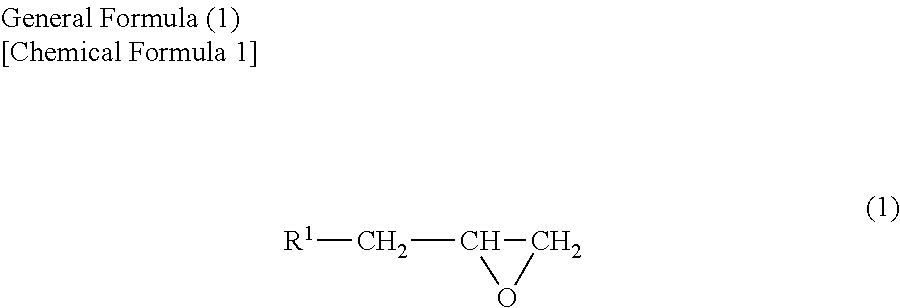Oxidant dopant agent for conductive polymer production, and a solution thereof, and a conductive polymer prepared by using either of them, as well as an electrolyte capacitor using the conductive polymer as an electrolyte
- Summary
- Abstract
- Description
- Claims
- Application Information
AI Technical Summary
Benefits of technology
Problems solved by technology
Method used
Image
Examples
example 1
[0110]5.7 kg of ferric naphthalenesulfonate (a molar ratio of 1:2.70 for iron versus naphthalenesulfonic acid) was dissolved to prepare 10 kg of an ethanol solution (1% of water content).
[0111]Then, 10 kg of the ethanol solution of the ferric naphthalenesulfonate above was put into a reaction vessel having an internal volume of 20 L, into which 300 g of dibutyl phosphate (5.26% with respect to the ferric naphthalenesulfonate) was added. Then, there was heated such that the temperature of the contents reached 80° C., and a reflux was continued for one hour to prepare an oxidant dopant agent solution.
example 2
[0112]Except that replacing with 10 kg of the ethanol solution in which 5.7 kg of ferric naphthalenesulfonate was dissolved, 10 kg of an ethanol solution (1% of water content) in which 4.7 kg of ferric naphthalenesulfonate (a molar ratio of 1:2.70 for iron versus naphthalenesulfonic acid) and 1 kg of ferric methanesulfonate (a molar ratio of 1:2.70 for iron versus methane sulfonic acid) was used. Other than the above, the same procedure as Example 1 was carried out to prepare an oxidant dopant agent solution.
[0113]In Example 2, 300 g of dibutyl phosphate was contained in the oxidant dopant agent solution in the same manner as Example 1. The quantity of the dibutyl phosphate was 5.26% with respect to the organic ferric sulfonate made by ferric naphthalenesulfonate and ferric methanesulfonate.
example 3
[0114]Except that replacing with 10 kg of the ethanol in which 5.7 kg of ferric naphtalenesulfonate was dissolved, 10 kg of an ethanol solution (1% of water content) in which 4.7 kg of ferric p-toluenesulfonate (a molar ratio of 1:2.70 for iron versus p-toluenesulfonic acid) and 1 kg of ferric methaesulfonate (a molar ratio of 1:2.70 for iron versus methane sulfonic acid) was used. Other than the above, procedure as Example 1 was carried out to prepare an oxidant dopant agent solution.
[0115]In Example 3, 300 g of dibutyl phosphate was contained in the oxidant dopant agent solution in the same manner as Example 1. The quantity of the dibutyl phosphate was 5.26% with respect to he organic ferric sulfonate made by ferric p-toluenesulfonate and ferric methanesulfonate.
PUM
| Property | Measurement | Unit |
|---|---|---|
| Percent by mass | aaaaa | aaaaa |
| Percent by mass | aaaaa | aaaaa |
| Boiling point | aaaaa | aaaaa |
Abstract
Description
Claims
Application Information
 Login to View More
Login to View More - R&D
- Intellectual Property
- Life Sciences
- Materials
- Tech Scout
- Unparalleled Data Quality
- Higher Quality Content
- 60% Fewer Hallucinations
Browse by: Latest US Patents, China's latest patents, Technical Efficacy Thesaurus, Application Domain, Technology Topic, Popular Technical Reports.
© 2025 PatSnap. All rights reserved.Legal|Privacy policy|Modern Slavery Act Transparency Statement|Sitemap|About US| Contact US: help@patsnap.com



